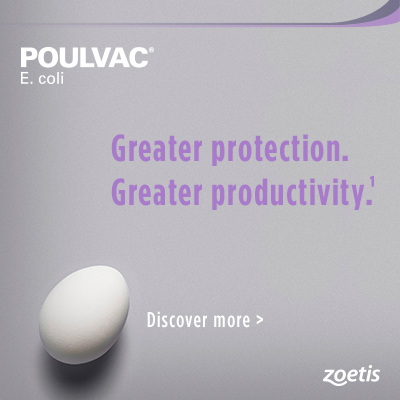Modified-live E. coli vaccine helps control mortality, improves livability in layer production
An interview with John Brown, DVM, senior technical services veterinarian and layer specialist, Zoetis
Q: Why is Escherichia coli vaccination so important in the layer industry?
JB: When layers die, E. coli is frequently involved maybe 90% of the time, either as a primary or secondary cause of death.1 If you take birds to a lab, they’re probably going to find it.
Before vaccines against E. coli were introduced, in my experience in layer flocks you’d get to about 75% or 80% production and mortality would spike, up to even 0.3% a week in some situations. Nearly every bird you’d post would have E. coli peritonitis and abdominal problems. But once the vaccine was introduced, I saw the incidence really decline, almost to the point where mortality rates were normal.
Q: What are the primary advantages of using Poulvac® E. coli in layers?
JB: Ease of use is a major strength. Anything mass-applied is so much easier for the producer. It can effectively be administered in the water or as a spray. It’s a very versatile vaccine.
In terms of the impact in flocks, we’ve seen much better feed conversion and general livability when faced with all the various challenges, plus reductions in condemnations.2 I’ve seen mortality in flocks return close to normal through early lay.
Q: Are there any specific examples of field performance you can highlight?
JB: I first learned about Poulvac E. coli back when I was working for a breeding company and admit I was skeptical initially. But I recommended it to a customer who was having major problems with E. coli, and within 3 weeks of vaccinating, their mortality was down to normal, despite their using it later in grow.
Then I suggested trying it the way it’s intended to be used, early on in grow. Their next three flocks had no E. coli problems. That’s when I became a believer and started recommending it all the time. Yes, it’s an investment, but at the time, everybody was a having a lot of problems and mortalities due to E. coli. If you can then show that it brings mortality down to close to normal or normal, then they’re sold.
Q: Is this vaccine just for layers?
JB: No. Use in the broiler segment is growing as producers increasingly recognize its benefits in terms of broiler health and performance, especially as the industry moves to limit antibiotic use. A US trial in broiler flocks demonstrated better feed conversion and lower mortality (after week one) and condemnations, while birds needed less antibiotic treatment for a shorter amount of time.3 The vaccine also works well for turkeys, but currently layers are still the dominant market.
Q: How do producers maximize the efficacy of the vaccine in the field?
JB: It’s fair to say that many producers use the vaccine when it is convenient for their labor, but for best results, the vaccine should be administered at day of age and then again at 12 to 14 weeks of age.
Q: Are there any issues with vaccine application in aviary-type and cage-free houses?
JB: The challenge with spraying the vaccine in these newer houses is it’s difficult to make sure every bird gets a dose and especially so because the vaccine doesn’t spread from bird to bird, like vaccines for infectious bronchitis would or Newcastle disease would. That’s why a lot of times I recommend a spray when the chicks are young and then in the water later, when the birds are in more confined areas, when it’s harder to spray every bird.
Q: Are there any situations where especially high prevalence of E. coli leads producers to use supplementary measures on top of the modified-live vaccine?
JB: There’s the occasional production facility that does tend to supplement the modified-live vaccine with an autogenous, killed vaccine. Using the killed vaccine alone may not be as effective, but customers have told me that they add it to a live E. coli vaccination program. That one is not mass applied; it’s injected, so it would probably be best to give it alongside a killed Salmonella vaccine around 12 to 14 weeks of age so as not to add handling for the birds.
Q: How are trends toward cage-free production and reduced antibiotic use affecting uptake of E. coli vaccination?
JB: The switch to cage-free presents its own set of problems in terms of managing E. coli well, as it’s harder to inspect individual birds and easier for disease to spread. That does tend to increase the search for solutions that can be applied to the whole flock and make a difference with the kind of production challenges that E. coli brings. The pressure for poultry veterinarians to reduce antibiotic use is another factor that’s seeing a shift toward prophylactic approaches to E. coli management, rather than a more reactive approach which might have previously been used.
1 Glisson JR McDougald LR Nolan LK Suarez DL Nair VL., Diseases of Poultry. 13th Ed., Wiley Blackwell, Ames IA. 2013, 751-805.
2 Data on file. Study No. B510-09-RFT.R, Zoetis, Inc.
3 Ibid.
All trademarks are the property of Zoetis Services LLC or a related company or a licensor unless otherwise noted.
TOOLBOX, Issue 29
Toolbox is a series of interviews with veterinarians and other technical specialists about their experiences managing antimicrobials, vaccines and other tools for poultry health. It is produced by the editors of Poultry Health Today on behalf of the US Poultry Business of Zoetis.
BIO-00332
Feb 2022
Posted on May 10, 2022













